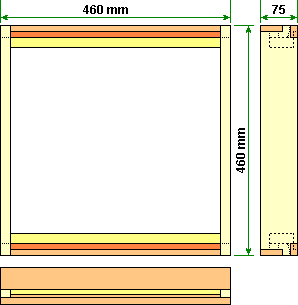|
|
|
|---|
Eke to suite National Bee Hives |
|---|
|
An EKE can be as simple as four planks of wood 50 mm - 100 mm wide nailed together to form a rim the same size as the hive box. This can be used over a crown board to house a contact feeder or a piece of comb that needs "emptying" of stores or brood. There are other uses as well... If you have only shallow boxes available and you need to use some deep frames then your eke can be placed under the shallow box and the deep frames will hang in the combination. I take this concept a little further... Our British National brood boxes are 225 mm tall and our supers are 150 mm. I make my ekes exactly 75 mm and make them to accept frame lugs in the same manner as the boxes. I fit a few with frame runners, but I use mainly use castellated spacers in these ekes, a few with 9's, some with 10's, some 11's and yet others with 12's spacing. |

|
|---|
Two of these ekes clipped together (using "Z" springs) make 150 mm and will take super frames. As my eke's have a selection of spacings available, the spacing of these frames depends on which eke is placed on top of the other.
A 150 mm super plus an eke makes 225 mm and will take brood frames or three ekes can be clipped together and perform the same job.
There is also another size of British Standard frame known as a 14" x 12" and a standard 225 mm brood box plus a 75 mm eke will take these with a slight encroachment on the space within the floorboard.
The word "EKE" originates from "to eke out" or stretch your resources. When bees were kept in straw skeps a "cap" or smaller skep was often placed on the top for honey production (much like supers today) if the cap became nearly full the beekeeper would add a ring of straw (about 75 mm deep) between the skep and the cap. It is this ring, that was built like a skep, that was known as an "eke". There is a complication to this in that if the ring was placed underneath the skep, then it was known as a "nadir".
Ekes are simple to make and prove very useful to have around in an apiary. There have been many occasions when I have been able to get out of... The sort of situation that has a habit of occurring in beekeeping, just by using one or two.
|
Cutting of parts (all dimensions are in mm). (When drawings of parts are available, the table rows will become live links.) The Grain should run along the longest dimension of any part. |

|
|---|
| Qty | Length | Width | Thickness | Material | Usage |
|---|---|---|---|---|---|
| 2 | 460 | 75 | 18 | Pine | Sides |
| 2 | 460 | 44 | 12 | Pine | Front and back top rails |
| 2 | 460 | 24 | 22 | Pine | Bottom rails (rebated & splayed) |
| 2 | 424 | 51 | 18 | Pine | Front and back |
| 2 | 424 | 19 (18) | 12 | Pine | Fillets |
Note The 12 mm top rails need to be set into the sides by 1 mm to keep end float on the frame top bars to a minimum. The front and back are set 9 mm up from the baseline.
|
This cross sectional view may help assembly. Scale = 1 pixel per 2 mm |
|
|---|
The top bee space version is on the "Rational Eke" page.
Written... 13 June 2001, Revised... 06 February 2002, Upgraded... 04 December 2005,
|